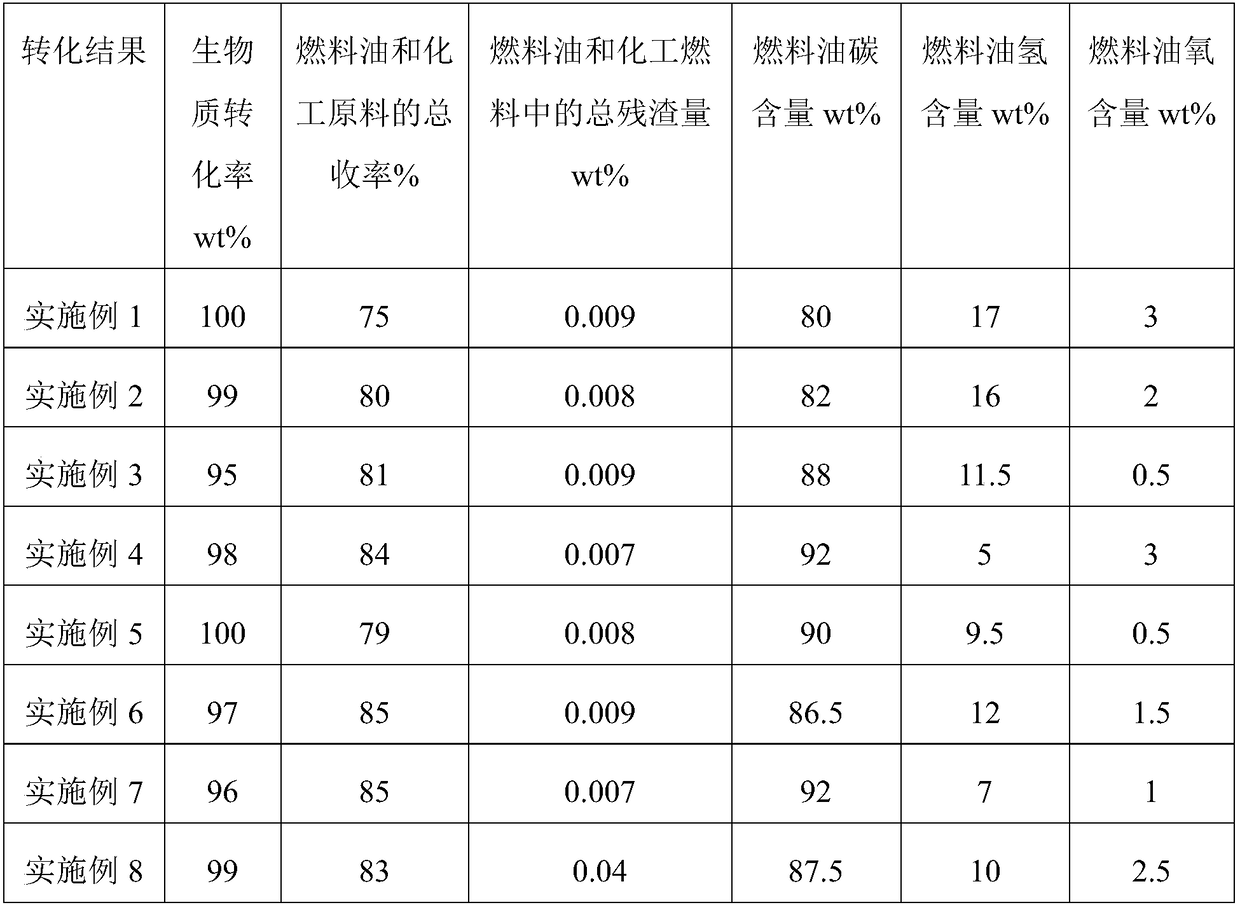Process for producing fuel oil and chemical materials by utilizing biomass
A technology of chemical raw materials and fuel oil, which is applied in the direction of fuel, petroleum industry, and preparation of liquid hydrocarbon mixtures, etc., and can solve problems such as high energy consumption, low yield of oil phase, and unstable transportation
- Summary
- Abstract
- Description
- Claims
- Application Information
AI Technical Summary
Problems solved by technology
Method used
Image
Examples
Embodiment 1
[0108] A process for producing fuel oil and chemical raw materials from biomass, comprising the steps of:
[0109] Biomass Pretreatment
[0110] Put the rice straw into the dryer and dry at 60°C for 4 hours until the water content is lower than 2wt%, and then send it into the superfine pulverizer for primary crushing, the median particle size after primary crushing is 200 μm, and then the primary crushed The rice straw is fed into the plodder to be compressed and extruded at a temperature of 50°C and a pressure of 2 MPa, and then subjected to secondary crushing treatment. The median particle size after secondary crushing is 40 μm, and the rice straw after secondary crushing is Straw bulk density is 440kg / m 3 ,spare.
[0111] Preparation of the first catalyst
[0112] (1) selecting biochar as the first biochar carrier;
[0113] (2) Loading iron oxide on the above-mentioned first biomass charcoal carrier to prepare the first catalyst.
[0114] The concrete method that ir...
Embodiment 2
[0131] A process for producing fuel oil and chemical raw materials from biomass, comprising the steps of:
[0132] Biomass Pretreatment
[0133] Put the wheat straw and reed straw into the drier and dry at 62°C for 4.5h until the water content is lower than 2wt%, and then send them into the superfine pulverizer for primary crushing, the median particle size after primary crushing is 220 μm, and then The primary crushed wheat straw and reed straw are sent to the briquetting machine for compression extrusion molding at a temperature of 50°C and a pressure of 1MPa, and then undergo secondary crushing. The median particle size after secondary crushing is 45 μm , the bulk density after secondary crushing is 470kg / m 3 ,spare.
[0134] Preparation of the first catalyst
[0135] (1) selecting biochar as the first biochar carrier;
[0136] (2) Loading iron oxyhydroxide on the above-mentioned first biomass charcoal carrier to prepare the first catalyst.
[0137] The concrete met...
Embodiment 3
[0153] A process for producing fuel oil and chemical raw materials from biomass, comprising the steps of:
[0154] Biomass Pretreatment
[0155] Put cotton stalks and corn stalks into a dryer and dry them at 50°C for 5 hours until the water content is lower than 2wt%, and then send them into an ultrafine pulverizer for primary crushing. The median particle size after primary crushing is 100 μm, and then the primary The pulverized cotton stalks and corn stalks were fed into a plodder for compression extrusion molding at a temperature of 30°C and a pressure of 3 MPa, and then secondary pulverization. The median particle size after secondary pulverization was 30 μm. The bulk density of cotton stalks and corn stalks after secondary crushing is 500kg / m 3 ,spare.
[0156] Preparation of the first catalyst
[0157] (1) taking biochar as the first biochar carrier;
[0158] (2) Loading iron hydroxide on the above-mentioned first biomass charcoal carrier to prepare the first cata...
PUM
| Property | Measurement | Unit |
|---|---|---|
| Bulk density | aaaaa | aaaaa |
| Granularity | aaaaa | aaaaa |
| Viscosity | aaaaa | aaaaa |
Abstract
Description
Claims
Application Information
 Login to View More
Login to View More - R&D
- Intellectual Property
- Life Sciences
- Materials
- Tech Scout
- Unparalleled Data Quality
- Higher Quality Content
- 60% Fewer Hallucinations
Browse by: Latest US Patents, China's latest patents, Technical Efficacy Thesaurus, Application Domain, Technology Topic, Popular Technical Reports.
© 2025 PatSnap. All rights reserved.Legal|Privacy policy|Modern Slavery Act Transparency Statement|Sitemap|About US| Contact US: help@patsnap.com

